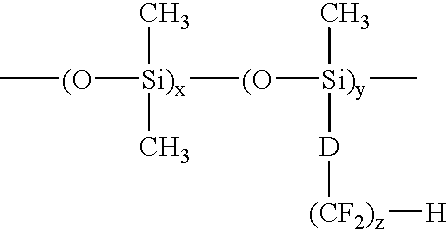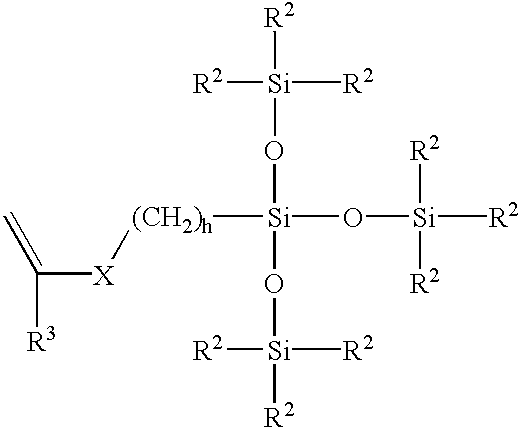Silicone hydrogels based on vinyl carbonate endcapped fluorinated side chain polysiloxanes
a technology of fluorinated side chain and silicone hydrogel, which is applied in the field of new polymer compositions and medical devices, can solve the problems of incompatibility of comonomers and inability to wear comfortably in the eye, and achieve the effects of low modulus, good properties for lens applications, and high oxygen permeability
- Summary
- Abstract
- Description
- Claims
- Application Information
AI Technical Summary
Benefits of technology
Problems solved by technology
Method used
Image
Examples
example 1-5
[0052]The vinyl carbonate endcapped polysiloxanes containing perfluorinated side chains of the present invention may be prepared according to the following general reaction scheme.
[0053]First, a cyclic siloxane tetramer, containing the perfluorinated side chain, is prepared according to Scheme I:
Next, the vinyl carbonate endcapped siloxanes are prepared by an acid catalyzed ring opening polymerization of this fluorinated cyclic siloxane tetramer (and optionally octamethylcyclotetrasiloxane) using a divinyl carbonate endcapped disiloxane, as shown in Scheme II:
[0054]The activated resin employed in Scheme II is preferably prepared by placing amberlyst-15 resin (100 g) in a 1000-ml Erlenmeyer flask with 500 ml of THF. This mixture is stirred for 18 hours, then the resin is filtered off and allowed to air dry. Next, the recovered resin is placed in a 1000-ml Erlenmeyer flask with 400 ml of 0.1N HCl. This mixture is stirred for 3 hours and the acid is decanted. The resin is washed with...
examples 6-57
[0059]A series of monomer mixtures, suitable for providing silicone hydrogel contact lenses copolymeric materials, were prepared by mixing the components in Tables 2-6. The solvent employed in these mixtures was 3,7-dimethyl-3-octanol. In these following tables, NVP denotes the hydrophilic monomer N-vinyl pyrrolidinone, and TrisVC denotes the monofunctional polysiloxanylalkyl comonomer 3-[tris(trimethylsiloxy)silyl] propyl vinyl carbamate. Additionally, these monomer mixtures included 0.5 parts by weight (pbw) of the initiator Darocure-1173. The amounts listed in Tables 2-6 are parts by weight.
[0060]These monomer mixtures were cured between two silane-treated glass plates under an ultraviolet (UV) light source with an intensity of 300 microwatts for about 2 hours. The cured films were then released, extracted in isopropanol and dried overnight. The dried films were soaked and hydrated in a borate buffered saline solution overnight before characterization. Tensile tests were performe...
example 58
[0066]Various monomer mixtures in Tables 2-6 may be used to cast contact lenses. The monomer mixture is placed on the molding surface of a first plastic mold section, shaped to provide an anterior contact lens surface, and a second plastic mold section having a molding surface shaped to provide a posterior contact lens surface, the monomer mixture being contained in the mold cavity formed between these two molding surfaces. This assembly is subjected to a UV light source to cure the monomer mixture. Following curing, the two mold sections are separated to recover the contact lens.
PUM
| Property | Measurement | Unit |
|---|---|---|
| Percent by mass | aaaaa | aaaaa |
| Fraction | aaaaa | aaaaa |
| Fraction | aaaaa | aaaaa |
Abstract
Description
Claims
Application Information
 Login to View More
Login to View More - R&D
- Intellectual Property
- Life Sciences
- Materials
- Tech Scout
- Unparalleled Data Quality
- Higher Quality Content
- 60% Fewer Hallucinations
Browse by: Latest US Patents, China's latest patents, Technical Efficacy Thesaurus, Application Domain, Technology Topic, Popular Technical Reports.
© 2025 PatSnap. All rights reserved.Legal|Privacy policy|Modern Slavery Act Transparency Statement|Sitemap|About US| Contact US: help@patsnap.com



